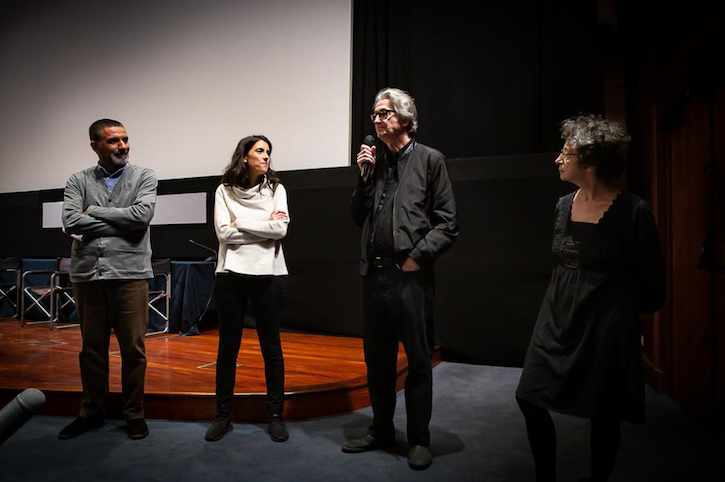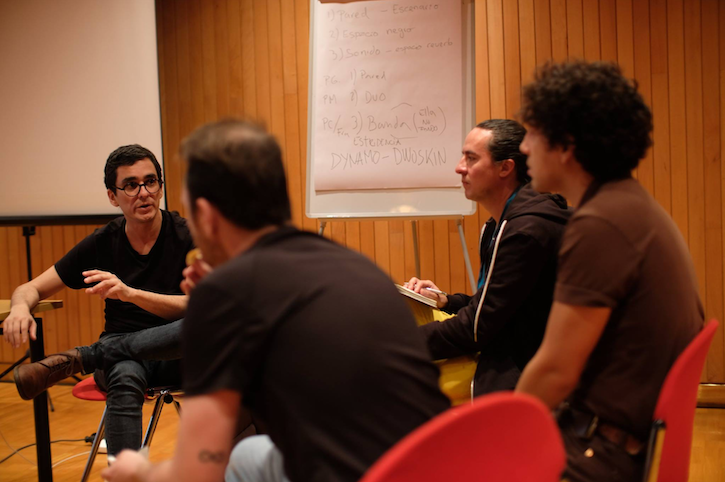Ways of Organizing: Passages
Cíntia Gil
We conceive of each edition of Doclisboa as a set of questions about the contemporaneity of film practices. Formed out of a multiplicity of proposals and forms, each festival has a singular context, its own audience, and of course, its own programmers and team. Each accommodates a multiplicity of practices, and therefore must form relationships between them.
While programming Doclisboa, we look at contemporary practices by considering their relation to historical film practices. Each new program provides a space for searching aesthetic problems, political issues, and various mutations that come to the surface when we consider the films, and all films, in the present tense. For example, performative cinema has been here for a long time, from Rouch to Maya Deren and many others; and conceptual video work today becomes more interesting if we consider it alongside works by Dziga Vertov, Abel Gance, and others. It is not about affirming a chronological approach to film history, it is about trying to resist the fascination of novelty and trends. If a film festival chooses a film based on its contemporaneity, it must also play with its history in that sense.
“Passages,” one of the sections in our program, consists of an exhibition in the form of a video installation of one or more artists that question the materiality of film and its reception. “Passages” is about the experience of documentary beyond the screen, and about simultaneity: how do the images operate when they are connected through space rather than through a sequential time organization? As part of “Passages,” we exhibited works by Chantal Akerman, Claire Fontaine, Elizabeth Price, Sharon Lockhart, and more. Screened in a gallery setting, these works were programmed to be in dialogue with the sections of the festival that are exhibited in a cinema setting. But the opposite is also of interest: we would also like to bring to the screen works that were previously made for the gallery space—to put them into dialogue with other works in the program. For example, when we screened installation works by Naeem Mohaiemen, Amber Bemak, Nadia Granados, and Louidgi Beltrame, it allowed for a different way of thinking about the relationship between these works to arise. Relationships are then thought of through a different set of terms: sequentiality not simultaneity, and so on. In short, the program is designed to think about films relationally as opposed to novelties. Everything we screen is responding to or is made in relation to something else.
In 2012 we started “Cinema of Urgency” after witnessing for the first time, following the end of the Dictatorship in Portugal, police brutality against demonstrators, the arrest of activists, and the disappearance of videos from social media platforms. In this section, we screened activist videos—ones that were recorded by random people and collectives who rarely had any training as filmmakers. Similarly, in 2013 we programmed a focus on Abounaddara, an anonymous Syrian Collective of amateur citizen- reporters. “Cinema of Urgency” has become a way of thinking about these films outside the immediacy and oblivion of the web—negotiating control and disappearance with availability. The work of programming defends this démarche of filmmaking as an important practice for today’s discussion on documentary. These films exist both in a printed catalogue, and are watched in a traditional cinematic context.
Every program we organize reflects a subjective approach to film and film history. This means certain biases of the programmer must be put forward. For those of us doing the gatekeeping, it is about affirming rather than validating the works because it is not about legitimacy, it is about assuming one’s stand and contributing an experience for the sake of the discussion.
It is obvious that a film festival is about exclusion, as much as it is about inclusion. That dynamic relies on our capacity to build a discourse that can integrate the films, that can communicate them to our audience, and that can somehow reflect back on the status of the film itself. But of course we have clear limits. Doclisboa was created as an alternative to television documentary, so we are not interested in programming television productions, only in invading television with films we defend— and that is a big struggle. We are less concerned with whether or not a film is a documentary than we are with challenging audiences to view a variety of forms as documentary. How do we change the reception of a film if we program it as a documentary? How can we build a collective space of reflection on our present moment through the films and activities around them? We defend film as the materiality of singular experiences that can be shared through the specificities of the cinematic. It’s not about truth, it’s about the experience of the real, and the capacity we have to complicate it in a collective and critical mode. We like to think we work under a “post-genre” philosophy—with all of the political and aesthetic consequences that come with doing away with the assumptions of genre. In practical terms, we do not classify the films we program by genre. Also, length is not a criteria for us. What we do affirm is that documentary today has more to do with the way experience and reception is organized than the filmic processes. The balance between programming and developing audiences is an ongoing process, not a criteria nor an immediate goal.
 Cintia Gil with Luis Ospina, DocLisboa 2018.
Cintia Gil with Luis Ospina, DocLisboa 2018.
As a temporary and spatially contained organization of films and activities, Doclisboa reshapes the circuits and schedules of people in Lisbon. This has a strong political and aesthetic potential: for the city center to change and for the “community” experience to become very tangible. As programmers, we must use this potential to create new circuits between different sections of the festival, and track the displacing effects of the programs themselves. There’s a certain “amusement” in experimenting with the city in this way with each new year.
Another issue we face is the involvement of young audiences. Although we do have quite a lot of screenings dedicated to younger audiences, we never program films that are produced specifically for that demographic. We continue to defend the idea that creating the right context, and having an open and shared dialogue is key for reaching any audience. For example, this year we are working with the productions of the Brazilian project Vídeo nas Aldeias a three-decades long project of filmic practice and film pedagogy in indigenous communities. These are films made, often times, as a struggle for surviving—video being used as a tool for confrontation. Children from four years old participate in ateliers where these films are screened and the results are quite impressive. In the last edition children saw Incident at Restigouche (1984) by Alanis Obomsawin and Of Whales, the Moon and Men (2000) by Brault and Perrault. In 2017, we screened Peter Watkins’ Culloden (1964) for young audiences. Any person can watch any film if a programmer accepts the challenge to build a link between a film and the audience; and if we do not demand that films and people immediately become friends. Audiences at DocLisboa are generally okay with getting a bit lost and developing new strategies to find their way into a program.
VIDEOS NAS ALDEIAS, Indians in Brazil. 4. WHEN GOD VISITS THE VILLAGE, 2000.
The main funders of Doclisboa today are the Lisbon City Council and the Portuguese Film Institute. These funds come with very few restrictions on us as programmers. The funding that comes from the European Education, Audiovisual and Culture Executive Agency, on the other hand, is quite restrictive. We are required to program a minimum number of films from the countries that participate in its MEDIA sub-program.. This consists of 70% of our exhibition catalogue. This funding structure dictates a relatively large portion of our program, and limits our capacity to show all the films we wish to. The international context within which Doclisboa exists is very demanding. Our ability to compete is defined less by our financial capacity to impose ourselves in the market than by our programming and our capacity to engage in dialogue with the artistic entities involved—filmmakers, film critics, and other programmers. This is a limitation, but also a very interesting place to be.
At a more concrete level, we created a project development lab called Arché, built in opposition of existing models of pitching and of fast processes. It’s a slow and intense model for a small number of projects, based on the idea that filmmakers and producers need to have a strong dialogue with peers before considering finances and sales. It’s a free program, acting as an alternative to the politics and economy of access to production today.
 Andrés Duque with Arche lab participants, DocLisboa 2018.
Andrés Duque with Arche lab participants, DocLisboa 2018.
At a more diffuse level, we work hard to be pertinent and meaningful as a place for dialogue between filmmakers, audiences, and other agents involved in the films. Today, international filmmakers and producers choose to premiere their films at Doclisboa not because we are a powerful film festival, but because they know they will find commitment to artistic and political dialogue. Every year we consciously work to build a program that not only interests our audience, but one that also “nourishes” the professionals that visit us.
Title Image Credit: DocLisboa, 2018.

